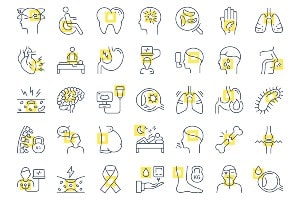About Methemoglobinemia

Learn about the disease, illness and/or condition Methemoglobinemia including: symptoms, causes, treatments, contraindications and conditions at ClusterMed.info.
Methemoglobinemia

| Methemoglobinemia |
|---|
Methemoglobinemia InformationHow common is methemoglobinemia, beta-globin type?The incidence of beta-globin type methemoglobinemia is unknown. How do people inherit methemoglobinemia, beta-globin type?This condition is inherited in an autosomal dominant pattern, which means one copy of the altered gene in each cell is sufficient to cause the disorder. What genes are related to methemoglobinemia, beta-globin type?Mutations in the HBB gene cause methemoglobinemia, beta-globin type. Hemoglobin consists of four protein subunits and four iron-containing molecules called heme. Heme molecules are necessary for red blood cells to pick up oxygen in the lungs and release oxygen to other cells in the body. Hemoglobin typically has two protein subunits call alpha-globin and two protein subunits called beta-globin. The HBB gene provides instructions for making beta-globin. Mutations in specific regions of the HBB gene lead to an atypical version of beta-globin known as hemoglobin M. Hemoglobin M interacts abnormally with heme molecules, which impairs the uptake of oxygen by red blood cells. As a result, a reduced amount of oxygen is delivered to cells throughout the body. Other types of methemoglobinemia can be caused by abnormal alpha-globin, a shortage of a particular enzyme called NADH-cytochrome b5 reductase, or unusual reactions to certain drugs or chemicals. What is methemoglobinemia, beta-globin type?Beta-globin type methemoglobinemia is an inherited blood disorder. It disrupts the function of hemoglobin, the molecule in red blood cells that delivers oxygen to cells throughout the body. Methemoglobinemia is characterized by increased levels of an atypical form of hemoglobin that is unable to deliver oxygen efficiently. In most individuals with beta-globin type methemoglobinemia, the only symptom is cyanosis, which is a bluish appearance of the skin, mucous membranes, or the area underneath the fingernails due to a lack of oxygen in the blood. Symptoms may appear as early as age 3 to 4 months. Methemoglobinemia symptoms do not improve when affected individuals are given additional oxygen, because oxygen cannot bind effectively to the abnormal hemoglobin. What other names do people use for methemoglobinemia, beta-globin type?
|
More Diseases
A | B | C | D | E | F | G | H | I | J | K | L | M | N | O | P | Q | R | S | T | U | V | W | X | Y | Z
Diseases & Illnesses Definitions Of The Day
- Noncancerous Colloid Thyroid Nodule (Thyroid Nodules) ‐ How are thyroid nodules diagnosed?, Introduction to thyroid nodules …
- Skin, Laser Resurfacing (Laser Resurfacing) ‐ CO2 Laser Resurfacing, Complications of Laser Skin Resurfacing …
- Malignant Fibrous Histiocytoma (Bone Cancer Overview) ‐ Are there any treatments or medications that relieve bone cancer pain? …
- Double Vision ‐ Is it possible to prevent double vision?, What are the symptoms and signs of double vision? …
- Ageusia (Taste Disorders) ‐ Are taste disorders serious?, Can taste disorders be treated? …
- Autism Screening and Diagnosis ‐
- Alpha-fetoprotein Blood Test ‐ In which situations are high blood (serum) levels of AFP used as a tumor marker? …
- Polymyalgia Rheumatica ‐ How do health care professionals make a diagnosis of polymyalgia rheumatica? …
- Stump Appendicitis (Appendicitis) ‐ Appendicitis definition and facts, Are there long-term consequences of appendectomy? …
- Gonorrhea (Gonorrhea In Women) ‐ Gonorrhea facts, How is gonorrhea diagnosed?, What are sexually transmitted diseases (STDs)? …